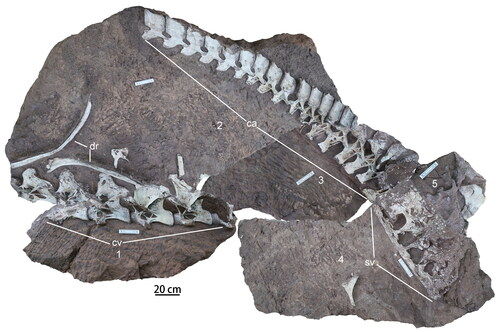MEANING: Ganzhou geology giant
PERIOD: Late Cretaceous
CONTINENT: Asia
Gandititan is a basal titanosaurian sauropod dinosaur from the Late Cretaceous of what is now China. It was a long-necked herbivore, typical of sauropods, with a relatively short tail, a characteristic of titanosaurs compared to other sauropods. Titanosauria have a wide range of body sizes, and Gandititan falls around the middle, slightly on the smaller side. Discovered with a fairly well articluated spine from neck to tail, Gandititan is estimated at about 14 m in total body length.

Abstract from paper: Large quadrupedal sauropod dinosaurs of the group Titanosauria were globally distributed in the Late Cretaceous. Many titanosaurian species have been discovered in eastern Asia, but most of them are controversial and represented by poorly preserved remains. Here, we describe a new titanosaur, Gandititan cavocaudatus gen. et sp. nov., based on a partial skeleton recovered from the lower Upper Cretaceous of Ganxian County, Ganzhou City, southern China, and comprising six articulated cervical vertebrae, two partial dorsal vertebrae, and a complete sacrum preserved in articulation with the first 17 caudal vertebrae and part of the right pelvis. Gandititan can be diagnosed on the basis of the following autapomorphies: long and narrow fossae present on the dorsal and ventral parts of the lateral surfaces of the cervical centra, sacral neural spines forming a dorsal platform with wave-shaped lateral margins, anteriormost six caudal vertebrae with bifurcated neural spines, the presence of prominent triangular flanges on the transverse processes of the anteriormost caudal vertebrae, a pair of slit-like foramina present on the ventral surface of each anterior caudal centrum, lateral surfaces of neural arches strongly excavated, additional spinoprezygapophyseal laminae present, and a prominent lamina extending horizontally between the bases of the pre- and postzygapophyses in some anterior caudal vertebrae. An expanded phylogenetic analysis places Gandititan as the sister taxon to Abdarainurus, within a clade of non-lithostrotian titanosaurs that also includes the Chinese titanosaurs Dongyangosaurus, Baotianmansaurus and Huabeisaurus, as well as the Argentine titanosaur Andesaurus. Such results imply the possible existence of a previously unrecognized group of titanosaurs in eastern Asia, and potential dispersal of titanosaurs between Asia and South America during the mid-Cretaceous.
Gandititan is from the Cretaceous. The Cretaceous is a geological period that lasted from about 145 to 66 million years ago. It is the third and final period of the Mesozoic Era, as well as the longest. At around 79 million years, it is the longest geological period of the entire Phanerozoic. The name is derived from the Latin creta, "chalk", which is abundant in the latter half of the period.
The Cretaceous was a period with a relatively warm climate, resulting in high eustatic sea levels that created numerous shallow inland seas. These oceans and seas were populated with now-extinct flora and fauna, while dinosaurs continued to dominate on land. The world was ice free, and forests extended to the poles. During this time, new groups of mammals and birds appeared. During the Early Cretaceous, flowering plants appeared and began to rapidly diversify, becoming the dominant group of plants across the Earth by the end of the Cretaceous, coincident with the decline and extinction of previously widespread gymnosperm groups.
The Cretaceous (along with the Mesozoic) ended with the Cretaceous–Paleogene extinction event, a large mass extinction in which many groups, including non-avian dinosaurs, pterosaurs, and large marine reptiles, died out. The end of the Cretaceous is defined by the abrupt Cretaceous–Paleogene boundary (K–Pg boundary), a geologic signature associated with the mass extinction that lies between the Mesozoic and Cenozoic Eras.
Gandititan is a sauropod. Sauropods are saurischian dinosaurs that had very long necks, long tails, small heads (relative to the rest of their body), and four thick, pillar-like legs. They are notable for the enormous sizes attained by some species, and the group includes the largest animals to have ever lived on land. Well-known genera include Brachiosaurus, Diplodocus, Apatosaurus and Brontosaurus.
The oldest known unequivocal sauropod dinosaurs are known from the Early Jurassic, and by the Late Jurassic (150 million years ago), sauropods had become widespread. By the Late Cretaceous, one group of sauropods, the titanosaurs, had replaced all others and had a near-global distribution. This group included the largest animals ever to walk the earth. Estimates vary, but the largest titanosaurs are estimated at upward of around 40 m, and weighing 100 t, or possibly even more.
As with all other non-avian dinosaurs alive at the time, the titanosaurs died out in the Cretaceous–Paleogene extinction event. Fossilized remains of sauropods have been found on every continent, including Antarctica.









